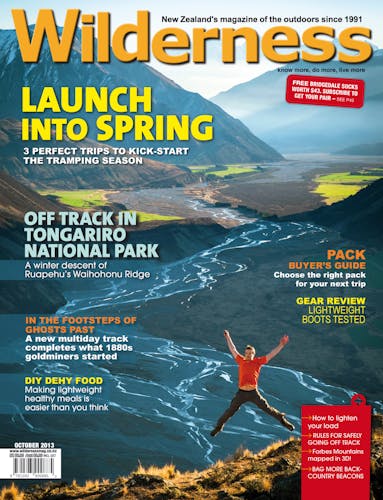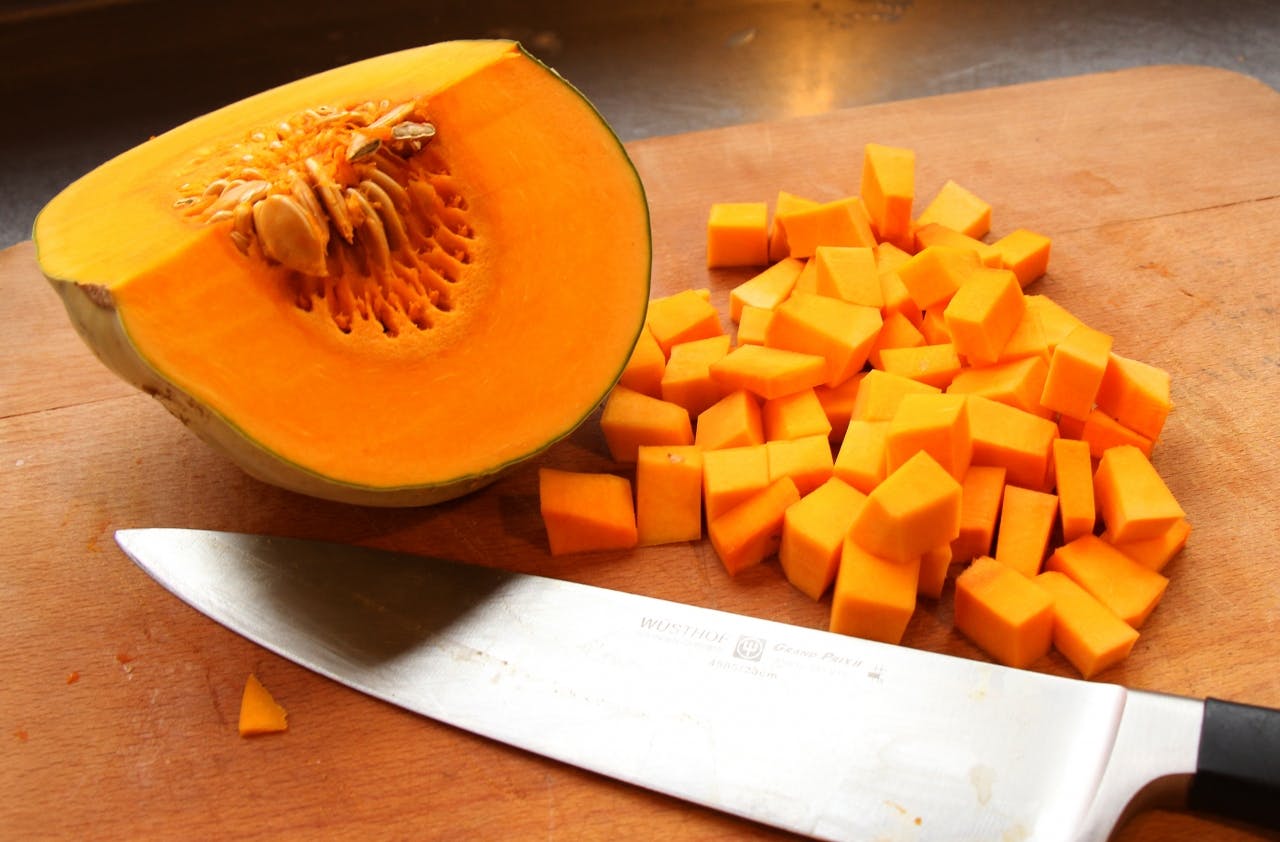Taste doesn’t have to be sacrificed to weight constraints when eating in the hills, as Edith Leigh discovers when she tries her hand at dehydrating her own tramping food
My pack straps are biting into my shoulders and hips. No matter how much I adjust them to shift the load, it hurts.
My feet are already sore. But we’re only a couple of hours into our two-day walk up the Matukituki Valley to Colin Todd Hut, so I grit my teeth, smile at my partner and keep trudging.
When we finally make it to the hut, I’m exhausted and as I peel off my boots I grimace. Blisters. On the bottom of my feet.
I’m relatively new to mountaineering and not used to carrying ice axes, crampons and ropes in addition to my usual load. But my fellow mountaineers stare in disbelief as fresh oranges and onions roll out of my pack.
Okay, I like my food, but perhaps this was taking it a bit too far.
That was 15 years ago when I was young and naïve. I didn’t worry too much about things like how heavy my pack was.
In fact, travelling light, whether it’s packing a backpack or a suitcase, has never been my strong suit.
So when Wilderness asked if I was interested in writing a story about dehydrating your own tramping food I wasn’t too sure. Obviously it is something I’ve never done before.
“It’s idiot proof,” Wolfgang Gerber, a keen tramper and dehydrator of tramping meals, assured me.
Food makes up a large portion of pack weight and a meal for four people, which might weigh 1700g can reduce to as little 275g, he says. His favourite tramping meal is chilli con carne, and he also dehydrates cooked rice to serve it with, which saves on cooking fuel.
Meals don’t look overly exciting once dehydrated, says Gerber, but cooking is a breeze. When you get to the hut, or campsite, put it in the billy, add water, then get yourself set up and have a cuppa. After about an hour, simply heat and eat.
Fellow Otago Tramping Club member Ann Burton has been dehydrating her own tramping food for 10 years, since she started going on longer tramping trips.
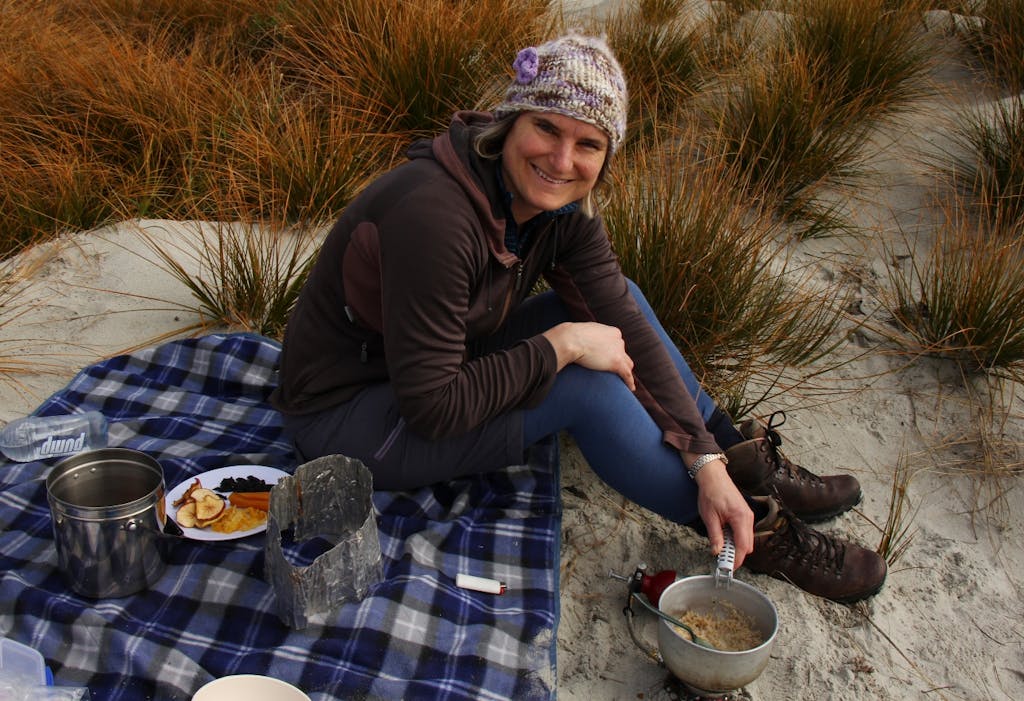
The author taste-testing a dehydrated meal in the field. Photo: Nik Leigh
“I was going with three fellas,” she says. “I wasn’t sure about some of them and what I’d get food wise. I’m fussy. I like nice food, so I thought maybe I should make the meals and then I could eat them.”
When tramping she enjoys meals such as sweet and sour pork, and stir fries with black bean sauce.
She has also seen people make up bags with a mix of dried red onions, peppers and herbs to add flavour to what they are cooking.
“It’s all trial and error really. You are only limited by your imagination. I just cook the meal as if I was doing it for tea that night and shove in whatever I have in the cupboard.”
Burton likes to add lots of vegetables cut very fine, and always uses mince as she finds pieces of meat, even if cut small, a bit chewy.
Burton says she usually makes the meal at night, leaves it to cool, then pops it in the dehydrator before she leaves for work in the morning and lets it run for about 12 hours.
Burton and Gerber both use a dehydrator to extract all the moisture out of the food, but dehydrating can work just as well using an ordinary convection or fan oven.
Retired teacher Noel Johnston has been dehydrating his own tramping meals in the oven since the 1980s. Before that he used to carry far too much food, he says. While he still carries the same amount of food now, dehydrating it means it weighs a lot less.
“Food is a big part of tramping and there is nothing nicer in the evening than to sit down and eat a really nice meal.”
He finds buying commercial freeze dried, lightweight meals expensive and doing it himself means he can add his own little touches, like adding chilli for extra spice.
During his teaching days he used to take school kids on tramping trips and get them to make their own dehydrated food as well. “There would be a few mothers ringing up to say ‘what does this mean’,” he says with a laugh.
That’s the decider for me. If a teenager can do it, then surely I can too.
I head home with a recipe for dehydrated Bolognese sauce. Once it is cooked I spread the mince across two trays, turn the oven to low, prop the door open with a wooden spoon and leave it for the day.
Ten hours later it’s hard and shrivelled, like sharp gravel. I tip it into a ziplock bag, put in the fridge and forget about it.
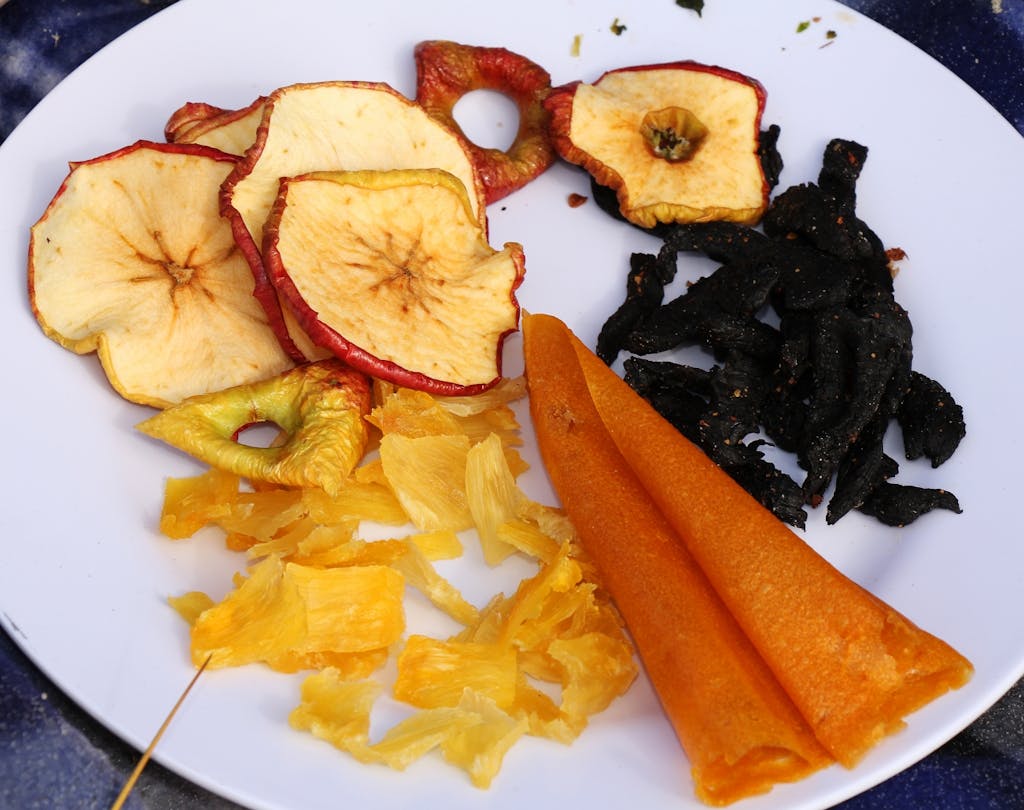
Dehyrated tinned pineapple pieces, sliced apple, venison jerky and peach fruit leather. Photo: Nik Leigh
A few weeks later I’m staring into the fridge looking for some lunchtime inspiration when I spot the dried Bolognese. Time for some taste testing.
I pour water over it until it’s just covered and then add a little more.
Half an hour later I come back to check on it. The mince pieces still feel rock hard in the centre so I add a little more water.
After another half an hour it’s time to boil it up and a few minutes later it is ready. I’m hungry now and it smells surprisingly good.
I decide to dress it up a little with some parmesan shavings and a sprinkle of dried basil. I fork up a mouthful, then another, and another. This is pretty tasty. Before I know it the bowl is gone and just writing about it is enough to make my mouth water.
I simply ate it at the kitchen table, but after eight hours of tramping it would be nothing short of delicious. I am now officially a convert to dehydrating my own food.
I decide to try my hand at some apple slices. After three hours in the oven they have turned into crisp, brown chips. Not too bad as far as a chip goes, but not much use for tramping.
I put the call out on Facebook: Does anyone happen to have a dehydrator in the back of the kitchen cupboard that I could borrow for a few weeks? A day later I swap my juicer for a dehydrator and now there is no stopping me.
The next four days the dehydrator is going non-stop as I experiment with fruits, vegetables and meats. Apple slices soaked in apricot juice are nice, tinned pineapple chunks sliced thin are full of flavour, and fruit leather is a breeze and full of yummy chewiness. My husband enjoys the venison jerky, which I marinated overnight in a mixture of soy, Worcestershire and sweet chilli sauce, while my three-year-old gorges herself on dehydrated vanilla yoghurt, which is even more scrumptious when rolled up with the fruit leather.
After just a few weeks of experimenting I cannot believe how easy it is to dehydrate your own food. In fact, I can’t believe I wasn’t doing this 15 years ago.
How much more enjoyable would that trip up to Colin Todd Hut have been if my pack had been 5kg lighter?
Tramping food aficionado Paul Garland, who has been around the hills and walked the Te Araroa Trail, and written a recipe book, Fast and Light, for trampers, says he is constantly amazed at the rubbish people eat while tramping.
He has seen packs full to the brim with canned food, another tramper carrying days’ worth of frozen pies and a group boiling up rice and peas to eat after five days of walking because they had run out of everything else.
Three days into the eight-day north-west circuit on Stewart Island he watched in amazement as a group of Germans pulled out a 2kg bag of carrots, a 1kg bag of onions and a 4kg bag of apples, and then proceeded to peel them.
A little thought and planning is all it takes to eat really well in the wilderness, he says. When on multiday trips, tramping in cold weather or at high altitudes, high energy foods are imperative.
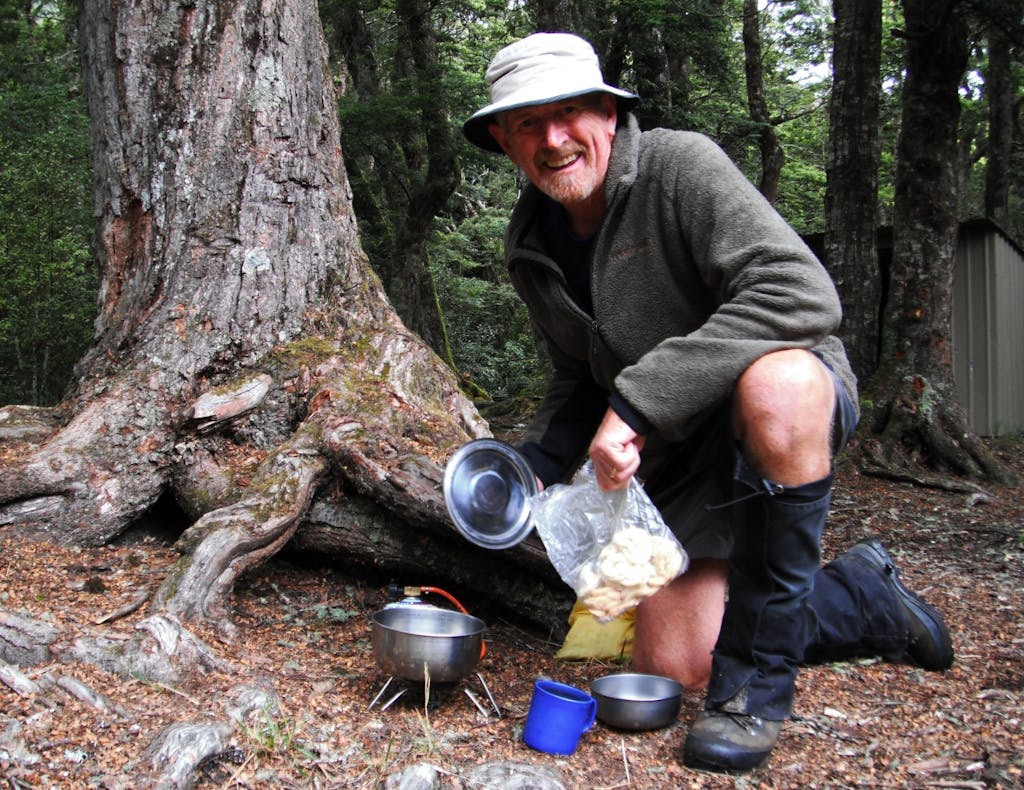
Paul Garland cooking up a storm on the trail.
An ex-boy scout, Garland is well prepared before he leaves, with every meal measured out and separately bagged.
“I can spend hours on the trail thinking about what I’m going to have for tea that night.”
A dehydrator is something he would recommend to any tramper, and compared to the cost of other tramping gear, such as boots, packs and raincoats, it is not even that expensive to buy.
One of Garland’s favourite dishes to dehydrate is a simple lemon chicken. Lemon zest intensifies during dehydration and the recipe makes a great base for any chicken meal.
I move lemon chicken to the top of my list of things to try. I’m also keen to experiment with Thai green curry using powdered coconut milk, a creamy mushroom pasta would be nice, or perhaps a peanut satay. The possibilities are endless.
A love of food is the one thing I’ve had in common with everybody I’ve talked to, and going tramping certainly doesn’t have to equate to tasteless packet pasta or rice risotto.
In fact, I can’t wait for my next tramping trip when I plan to eat gourmet meals but carry a wonderfully light pack.
Top tips for dehydrating meals
- Use high quality mince and vegetables
- Dehydrate cooked rice as well to save on stove fuel
- Big chunks of meat or vegetables will not only take longer to dehydrate, but longer to rehydrate – not great when you arrive at a hut or campsite starving
- Try recipes out at home first to avoid ending up with something inedible three days into a five day tramp
- When not tramping the same week dehydrated food is prepared, store it in an airtight container or ziplock bag in the freezer
- Fats don’t dehydrate well and may go rancid so stay away from fatty foods and use none or small amounts of oil when cooking
- When reconstituting, most meals need to soak for about an hour, some may need longer. Remember you can always add more water, but you can’t take it away.
- Fruit takes a long time to reconstitute. Add some moisture to the bag in the morning and it should be plump and juicy for an evening dessert
- Try blitzing dehydrated food, like pumpkin, in the food processor for faster reconstitution – great for adding to soups
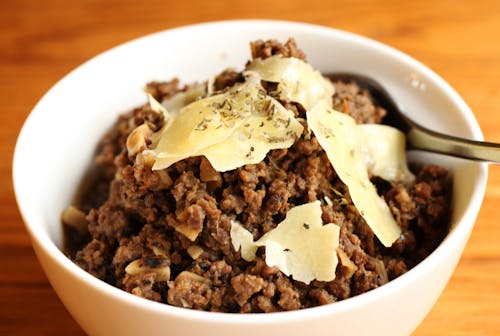 Dried Bolognese sauce
Dried Bolognese sauce
Serves four. Use very lean meat and fry without using any extra fat or oil.
Ingredients
600g lean topside mince
2 medium onions, finely chopped
2 cloves of garlic, crushed
½ cup tomato paste
¼ cup water
2 tbsp Worcestershire sauce
1 tbsp soy sauce
2 tsp dried basil
¼ tsp cayenne pepper
Method
Fry mince, onion and garlic on medium heat, stirring to break up lumps until mince is no longer pink. Pour off any fat.
Add remaining ingredients, reduce heat to low and simmer for 15 minutes. Spread the mixture as thinly as possible on two oven trays.
If drying in an oven with a fan, check the instruction book for drying details. As a general guide, turn the thermostat to low, 65°C, and the oven selector to defrost or fan bake. Place trays in oven and leave for 6-8hr. Turn mince mixture occasionally and crumble it. When done, the mince should be dry and brittle.
In a conventional oven, turn oven selector to bake and thermostat to its lowest setting. Prop the door open a few centimetres with a wooden spoon and leave for about 8-10hr.
Once mixture is cool, pack in a plastic bag and store in the refrigerator until departure.
To reconstitute, add an equal volume of water, bring to the boil and simmer for about 10 minutes. Serve with pasta.
Recipe courtesy of food writer Joan Bishop
Lemon chicken
Makes about 120g as a base for chicken tramping meals.
Ingredients
400g fresh chicken mince
2 tbsp olive oil
Grated rind and juice of 2 lemons
Salt and pepper
Method
Add oil to frypan, seal off chicken mince, add lemon rind and juice, and salt and pepper. Cook for about 20min until chicken is well cooked and forms dry crumbles.
Dehydrate for 4-6hr until chicken mince ‘rattles’ like dry seeds. Store in airtight plastic container in deep freeze until needed.
For use in recipes, 1/4cup (30g) of dried chicken will make up about 1/2cup of fresh cooked chicken.
Recipe courtesy of Paul Garland (www.campfirecreations.co.nz)





